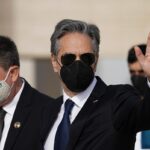
The decisions by Finland and Sweden to abandon the neutrality they adhered to for decades and apply to join NATO is the strongest indication yet of a profound change in Europe in the face of an aggressive Russian imperial project.
The two Scandinavian states have in effect made clear that they expect the threat from President Vladimir V. Putin’s Russia to be enduring, that they will not be cowed by it, and that after the Russian butchery in Bucha, Ukraine, there is no room for bystanders. Theirs is a declaration of Western resolve.
“Military nonalignment has served Sweden well, but our conclusion is that it won’t serve us equally well in the future,” Sweden’s prime minister, Magdalena Andersson, said on Sunday. “This is not a decision to be taken lightly.”
Because the Finnish and Swedish militaries are already well integrated with NATO, one reason the application process may go quickly, the immediate impact of the countries’ change of strategic course in light of Russia’s invasion of Ukraine will be less practical than political.
This is a new Europe in which there is no more in-between space. Countries are either protected by NATO or they are on their own against a Russia ruled by a man determined to assert Russia’s place on the world stage through force. For Sweden, and especially for Finland, with its 810-mile border with Russia, Mr. Putin’s decision to invade a neighbor could not be ignored.
They were not alone. Germany, a generally pacifist nation since it emerged from the rubble of 1945, has embarked on a massive investment in its armed forces, as well as an attempt to wean itself of dependence on energy from a Russia it had judged as, if not innocuous, at least a reliable business partner.
“NATO enlargement was never a cause of Mr. Putin’s decision to invade Ukraine, but it is certainly a consequence,” said Nathalie Tocci, the director of the Institute for International Affairs in Rome. “Sweden and Finland now see a Russia that is revanchist and revisionist in a way that is much more dangerous than during the latter part of the Cold War.”
Sweden and Finland judged neutrality to be in their interests when faced by the Soviet threat, and in the Swedish case for centuries before that. They did not alter course, although they did join the European Union, in the more than three decades since the Cold War’s end.
The shift in sentiment in the two countries in the past several months has been dramatic, one measure of how Mr. Putin’s determination to push NATO back and weaken support for it has produced the opposite effect — the rebirth of an alliance that had been casting around for a generation for a convincing reason to exist.
Where no more than a quarter of the population in Sweden and Finland supported joining NATO last year, that number has risen sharply today — hitting 76 percent in a recent poll in Finland. Sweden’s governing Social Democratic Party, the country’s largest party and long a bastion of nonalignment, has embraced NATO membership in an extraordinary turnabout.
“Putin climbed into a tree and does not know how to get down,” said Nicole Bacharan, a French foreign policy analyst. “Now he will face a NATO that is stronger and bigger and more determined.”
Article 3 of NATO’s founding treaty says that members must “maintain and develop their individual and collective capacity to resist armed attack” through “continuous and effective self-help and mutual aid.” In the case of Sweden and Finland, these capacities have already been extensively developed through close cooperation with NATO.
Carl Bildt, a former Swedish prime minister and foreign minister, said: “We were on a glide path to a closer relationship with NATO. But rocket fuel was given to that particular path on Feb. 24” — the date the Russian invasion of Ukraine began.
He added: “Our decision reflects the view that Russia will remain a complicated place for a long time, and the war in Ukraine will be fairly long, with an erratic and highly revisionist leadership in the Kremlin for the foreseeable future.”
Asked if Sweden feared retaliation from Russia, Mr. Bildt said “you never know with Russia, but the mood is fairly confident.”
The assessment that the Ukraine war may well be long is now widely shared in Europe. Mr. Putin did not only take on his neighbor; he took on the West and an America portrayed as an “empire of lies.”
It took about 20 years from the Versailles Treaty of 1919 for Germany to respond to perceived humiliation by sending the Third Reich’s war machine across its neighbors’ border, igniting World War II. It took about 30 years for Mr. Putin’s brooding resentment over the perceived humiliation of the breakup of the Soviet empire to lead to a full-scale invasion of Ukraine.
The Russian president seems unlikely to reverse course, even if his war has gone badly up to now.
In practice, both Finland and Sweden have lived for a long time with Russian nuclear weapons in nearby Kaliningrad, the Russian enclave sandwiched between Poland and Lithuania on the Baltic coast.
“These countries are used to Russian violations of their airspace, they know the risks are there,” Ms. Tocci said. “But the security gains with NATO are incomparably higher than any added risk.”
Russia-Ukraine War: Key Developments
Inching closer to NATO. Finland’s government announced that the nation would apply for NATO membership, hours before Sweden’s governing party said that it also supported joining the alliance. If accepted into NATO, both nations would set aside a long history of military nonalignment.
Still, Mr. Putin has alluded more than once to Russia’s sophisticated range of nuclear weapons, and suggested he would not hesitate to use them if provoked. That threat is there not only for Finland and Sweden as they abandon military nonalignment, but for all of Europe and beyond.
Ms. Tocci spoke during a visit to Estonia, one of the three Baltic states formerly part of the Soviet Union that joined NATO in 2004. “There is general delight here that the Baltic Sea will now be a NATO sea, and to Estonians, the Finnish and Swedish decisions feel like a vindication,” she said.
For a long time, even up to the eve of the Russian invasion, Europe has been divided. Countries close to the Russian border — like the Baltic states and Poland — took a Russian threat seriously from bitter historical experience, while countries farther west, including Germany and France, were more intent on enjoying the peace dividend of the Cold War’s end than looking Mr. Putin’s ambitions in the eye.
These illusions persisted even after Mr. Putin annexed Crimea in 2014, stirred up a war in the eastern Donbas region of Ukraine the same year, and used military force to win the endgame in Syria, using brutal methods honed in Chechnya many years earlier and evident since February in Ukraine.
In the end, the countries closest geographically to Russia, and most immediately threatened by it, were right. Finland and Sweden have witnessed that up close.
Europe is now largely united in its determination to resist Mr. Putin and ensure he does not win the war in Ukraine. The United States, which had its own Russian illusions, has refocused on Europe and is determined not only to save Ukraine but to weaken Russia. These are not short-term ambitions.
“We do have a changed Europe,” Mr. Bildt said. “We will have a stronger NATO, with defense spending up, politically more cohesive, with a sense of purpose. We will also get a stronger European Union, with more complementarity between it and NATO.”
Europe, of course, will also be challenged economically and otherwise by any long war. And the countries in between — essentially, Moldova and Georgia, stuck in a no-man’s land on the fringes of Russia without NATO protection — will face treacherous challenges.
Finland and Sweden learned one core lesson from Ukraine. After the NATO announcement in 2008 that Ukraine and Georgia “will become members of NATO,” a decision taken with scant consideration of how or when to achieve that objective, the thorny issue of Ukraine’s membership was left floating by Western leaders who did not want to provoke Mr. Putin further.
This made no difference to Mr. Putin’s calculus. He invaded Ukraine just the same, inventing a Nazi threat and arguing that Ukrainian statehood was a myth. Sweden and Finland were not going to suffer the same fate through misguided restraint. “They learned a lesson,” Ms. Tocci said.
The question remains of how Mr. Putin will get down from his tree. He called the Finnish decision “a mistake,” and insisted there was no Russian threat to the country. He also cut off Russian supplies of electricity to Finland. There is no sign of his abandoning his conviction that force will eventually deliver Russia’s strategic aims.
“Even if Putin realizes he made a mistake, I doubt he will ever admit it,” Mr. Bildt said. “The consequences would be too momentous. This was not a small mistake. It was a catastrophic strategic error of the first order.”




